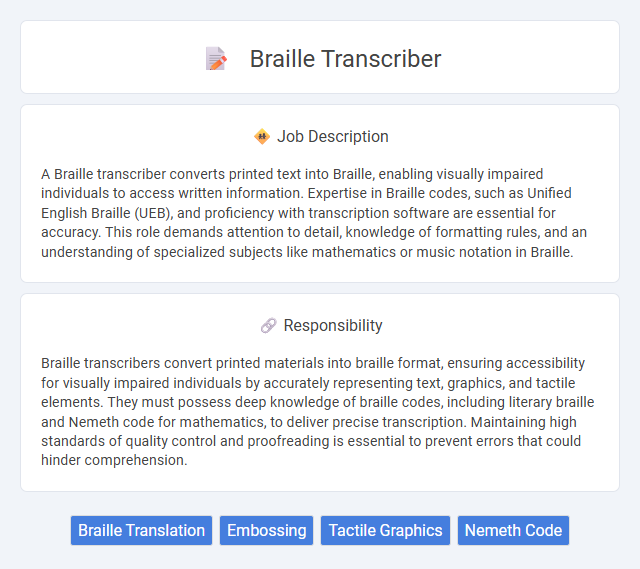
A Braille transcriber converts printed text into Braille, enabling visually impaired individuals to access written information. Expertise in Braille codes, such as Unified English Braille (UEB), and proficiency with transcription software are essential for accuracy. This role demands attention to detail, knowledge of formatting rules, and an understanding of specialized subjects like mathematics or music notation in Braille.
Individuals with strong attention to detail and patience are likely suitable for a Braille transcriber job, as the role requires accurate and precise transcription of text into Braille. Those with visual impairments might find this job particularly rewarding if they possess adequate tactile sensitivity and familiarity with Braille codes. However, candidates with limited manual dexterity or difficulty focusing on repetitive tasks might find the job challenging.
Qualification
A Braille transcriber must possess proficiency in Braille code, including Grade 1 and Grade 2 Braille, alongside strong literacy skills in the source language. Certification from recognized institutions such as the Library of Congress or the National Federation of the Blind is often required to ensure accuracy and adherence to transcription standards. Familiarity with assistive technologies and tactile graphics transcription further enhances a transcriber's qualification for this specialized role.
Responsibility
Braille transcribers convert printed materials into braille format, ensuring accessibility for visually impaired individuals by accurately representing text, graphics, and tactile elements. They must possess deep knowledge of braille codes, including literary braille and Nemeth code for mathematics, to deliver precise transcription. Maintaining high standards of quality control and proofreading is essential to prevent errors that could hinder comprehension.
Benefit
Braille transcribers are likely to benefit from contributing to accessibility and inclusivity for visually impaired individuals by converting written materials into braille. The job may offer a sense of fulfillment and purpose as it supports education and independence within this community. Opportunities for remote work and specialized training in braille transcription could also enhance professional development and job satisfaction.
Challenge
The job of a Braille transcriber likely involves complex challenges related to accurately converting printed text into Braille, which requires a strong understanding of Braille codes and language nuances. There is a probability that transcribers face difficulties in maintaining the integrity of formatting and meaning, especially with scientific or technical materials. Adapting to evolving tools and ensuring accessibility standards are met could also present ongoing challenges in this role.
Career Advancement
Braille transcribers with advanced skills in digital tools and specialized software can progress to supervisory or quality control roles within transcription agencies. Gaining certification from recognized bodies like the Library of Congress enhances job prospects and opens opportunities in education or accessibility consulting. Continuous professional development in emerging technologies is crucial for career growth in this evolving field.
Key Terms
Braille Translation
Braille transcribers specialize in converting printed text into braille script to enhance accessibility for visually impaired individuals. Mastery in braille translation software and adherence to standardized braille codes ensure accurate and readable tactile documents. Expertise in literary and technical braille is essential for producing materials across diverse subjects and formats.
Embossing
A Braille transcriber specializing in embossing converts written content into raised Braille characters using specialized embossing machines. Mastery of digital Braille embossers ensures accurate tactile reading surfaces for visually impaired users, enhancing accessibility and literacy. Precision in formatting and alignment during embossing directly impacts the quality and readability of Braille texts.
Tactile Graphics
Braille transcribers specializing in tactile graphics convert complex visual information into raised, touch-readable formats to enhance accessibility for visually impaired individuals. They use specialized software and embossers to accurately represent charts, maps, and diagrams in Braille, ensuring tactile clarity and comprehension. Mastery of spatial layout and adherence to Braille standards are essential for producing effective tactile graphics that support independent learning and navigation.
Nemeth Code
A Braille transcriber specializing in the Nemeth Code converts complex mathematical and scientific materials into Braille for visually impaired users. Mastery of the Nemeth Code ensures accurate representation of algebra, geometry, and calculus symbols, essential for effective learning and communication. Proficiency with specialized software and attention to detail are critical to maintaining precision and accessibility in Braille transcription.
 kuljobs.com
kuljobs.com